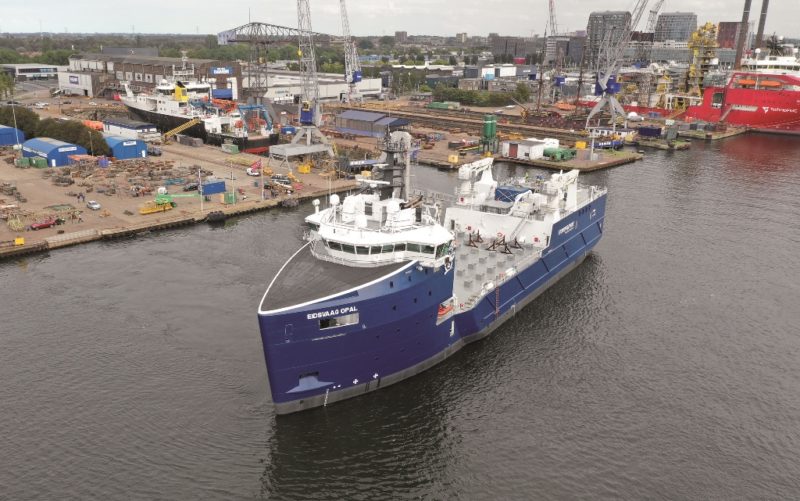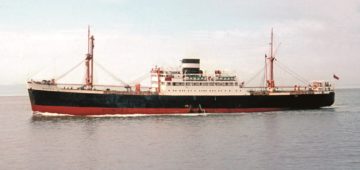As has been mentioned before, the Offshore Oil and Gas Industry has taken a hammering in the last few years, the downturn arriving just when order books were full of Platform Supply Vessels (PSVs) among other associated vessel types, including many new designs. Compounding factors include historically low oil prices, halted exploration projects and reduced production. This vicious circle is completed by a substantial drop in support vessel day rates. Damen Shipyards Group entered the second decade of the new millennium with a brand-new PSV design, the 3300 CD. This new breed was 80.10m long with a 16.20m beam, 6.15m draught with a speed of 13.6 knots. The 3,017gt PSV had a deadweight of 3,330t and was propelled by two CAT C32 generator engines, each 994 ekW at 1800 rpm, powering two SRP 1215 FP 1,500kW Schottel GmbH electric thrusters, each equipped with 2400mm fixed pitch propellers in nozzles. The PSV 3300 CD also boasted a 720m2 cargo deck area and a 1,400t deck load at 1m above the deck. The cargo area featured a tweendeck, the forward section of which housed utility and machinery spaces with storage tanks located aft towards the stern for ballast/drill water (1224m3 capacity), service fuel oil (300m3 capacity), potable water (769m3), fuel oil & base oil (1028 m3 capacity), liquid mud/brine (860m3 capacity) and 250m3 of dry bulk storage.
The first PSV 3300 CD to be launched was the World Diamond at the Damen Galati Shipyard in Romania on the River Danube and she was delivered to her owner, World Wide Supply, in June 2013. The Galati shipyard began co-operating with Damen in 1994, when the latter started subcontracting hulls of cargo vessels to the yard. This liaison worked out very well and in 1999 the shipyard officially joined Damen Shipyards. An ambitious investment plan followed which mainly focussed on the improvement of efficiency and on the working conditions. Damen Shipyards Galati was transformed into a modern and top-quality shipyard and, from then until 2011 when the PSV 3300 CD newbuilds were ordered, the yard had built over 270 vessels, an average of 20 vessels a year. Some of the yard’s most recent work for Damen includes building double-ended ferries for BC Ferries, as featured in a previous Newbuild of the Month. The World Diamond was the first of 4 PSC 3300 CD examples ordered in December 2011 with an option for a further 2 taken up in February 2012. These sleek, yellow vessels were named after gemstones with the other 5 being christened World Peridot/Pearl/Emerald/Opal & Sapphire. All were delivered June-December 2013.
The downturn hit the ship’s Owner, World Wide Supply, hard and in October 2016 the company laid up its last two active PSVs, which had been on charter to Petrobras, namely the World Emerald and World Sapphire, the latter being the last of the 6 PSVs delivered. Their employment ended after the Brazilian flagged vessels operating off Brazil had blocked their use, coupled with the expiry of a 60-day charter extension approved by the Agencia Nacional de Transportes Aquaviarios. The duo had previously been objected to by the Brazilian local tonnage before the annual renewal of the Brazilian Certificate of Chartering Authorisation (CAA) in March 2016 but the contracts were prolonged by 60 days each after Petrobras successfully applied for extensions. The two PSVs were redelivered and sent for lay-up in Cadiz, Spain after barely 3 years of a working life whilst the other four sisterships were already in lay-up. When new, four of the six World Wide Supply PSV 3300s secured long-term contracts supporting Petrobras whilst the remaining two were offered to the North Sea spot charter market.
From Downturn to Diversification
As may be apparent by now, this Newbuild of the Month feature is in fact another in the lesser series of Rebuild of the Month. Recognising the alarming number of relatively new Platform Supply Vessels becoming casualties of the troubled offshore fleets, Damen Shipyards Group announced in 2016 that it had developed a committed response to the redundant PSVs littering quaysides and fjords. The Dutch company’s solution involved converting idle PSVs into vessels capable of taking on roles in alternative sectors such as aquaculture, shipping and defence. New roles include a Container Feeder with one of the most advanced designs being the Damen Live Fish Carrier 8916 for the aquaculture industry. In addition to permanent conversion concepts, Damen also created temporary design proposals that can be applied to vessels originally built by Damen or other shipbuilding companies.

The 3,017gt/2013-built World Opal was the fifth PSV 3300 CD delivered by Damen and, once unemployed, she found herself laid up with sister vessel World Peridot in a Norwegian fjord for four years. Having explored newbuild and conversion options, shipping company Eidsvaag, based in Frøya, Central Norway, purchased this PSV from Borealis Maritime in August 2019 with a view to converting her to a fish feed vessel for a contract with fish feed producers EWOS Cargill and Skretting. These two companies had selected Eidsvaag to be responsible for the planning and handling of transport, including the 16 ships currently under contract. Combining the fleets is intended to reduce shipping traffic and decrease greenhouse gas emissions by one fifth. The collaboration was appropriately christened Fjordfrende (Fjord Friend) and commenced on 1st June 2019 for an initial period of 5 years. Renamed Eidsvaag Opal, the dead PSV was towed away from Fosnavåg, Norway on 21st September 2019 by the 365gt/2015-built tug Dian Kingdom, arriving at Amsterdam five days later. Damen Shiprepair & Conversion then set about transforming the vessel for her new life in Dry Dock No.1 in October 2020. Damen Shiprepair Amsterdam (DSAm) opened in 1920 as NDM (Nederlandse Dok Maatschappij) in response to the lack of competition among docking companies in the Port of Amsterdam. The modern-day facility is perhaps best described with the phrase ‘going the extra yard’ with efficient teamwork and personal service being the key factors for a successful project completion. DSAm is able to accommodate vessels up to 250m in length and the yard has developed a focus on offshore and special purpose vessels. Ship conversions are a speciality and, as any shipping company will know, changing the use of a ship or making significant changes to its capabilities is a major undertaking. The offshore sector has provided several complex projects such as converting drilling rigs to accommodation units and transforming conventional ships into offshore installation vessels by lengthening decks and adding accommodation, cranes, thrusters and DPS.
DSAm has also lengthened/widenened vessels including ferries and fishing trawlers, with other areas of expertise including changing propulsion systems to hybrid or pure LNG to enable ships to take on new roles in emission control areas. The addition of pods, thrusters and stabilisers can also transform the capabilities of a ship, and DSAm is a leader in the installation of marine access systems. Conversions can deliver major savings in both time and cost compared to a new build and require fewer inputs. Besides the Eidsvaag Opal, other notable projects include the conversion of a Containership into a windfarm construction vessel and a former navy vessel into a hydrographic support vessel. During the project to transform the World Opal into the Eidsvaag Opal, the hull was cut in two sections to permit the insertion of a new 5m section to create a new length of 84.94m. The PSV 3300 CD’s beam was also increased to 18.20m using a series of 1.2m side boxes to provide additional stability and cargo capacity. The project required considerable steelwork, 31 steel sections overall, totalling 875t. The shipyard also integrated 35 new silos and a big bag hold, enabling the Eidsvaag Opal to transport up to 2,800 tonnes of fish feed. Damen also outfitted the vessel with a discharge system of conveyors, buckets, elevators and a discharge arm. Two large 100t capacity knuckle boom deck cranes are located atop the new cargo hold towards the stern for lifting the large bags of feed in/out of the ship’s bag hold. Aukra Maritime was awarded the contract to supply these cranes plus two others, two side hatches and a deck hatch for cargo handling. The fish feed is transported both in sacks and in bulk. The transformation of the vessel required the removal of 51km of cable, including 15km from the old cargo systems alone (totalling 480 cables) plus the installation and connecting of 1,237 new cables. This work was carried out by FMJ Marine Automation. Damen Shipyards Amsterdam secured the tender to carry out the conversion due, amongst other things, to its close proximity to Niron Staal, Damen’s specialist steel fabricator. Another factor was Damen’s previous conversion experience for the aquaculture sector and having built the PSV in the first place. The covered forward superstructure on board the Eidsvaag Opal, from the main deck level to C Deck, houses various utility rooms, crew and officer’s mess rooms, galley, day rooms, offices etc. plus the cabin accommodation for the 16 officers and crew. Cabins are also available, each featuring internet access, a telephone and satellite T.V. Above C Deck is the Bridge Deck.
Like many things in 2020, progress on the conversion was affected by the coronavirus pandemic with the yard being required to cease work on the project for one week, in order to implement robust safety measures. Thanks to this, the work was then able to continue with minimum risk to health. Despite the need to socially distance on site and the vessel, work continued at a good pace, taking in total 346 days. Once released by the shipyard after sea trials in September/October, the completed Eidsvaag Opal underwent her first loading in Norway during the week commencing 19th October in order to test the new cargo systems. This involved the vessel carrying 180t of feed in the silo and 55t in bags in the big bag hold. The trials went very well, requiring only small adjustments to the loading equipment in the big bag cargo bay. The feed was unloaded at a fish farm close to Tromsø, at which point the capacity and quality was approved by the product owner. During a second test a week later, a larger 700t payload was transported. The vessel’s official handover to Eidsvaag AS took place on 23rd November 2020, just past the 7th anniversary of her delivery as a newbuild. The ship’s new operating company was founded in Skretting in 1981 with fish food being distributed by road initially, to Frøya and Hitra. However, growth dictated a switch to deliveries by sea with the family-run business purchasing the MS Frøyfrakt in 1995. In 2001, Eidsvaag AS was awarded a contract for all local sea freight by Skrettingfõr in Norway.
The fleet consists of the Aqua Fjell, Aqua Fjord, Aqua Junior, Aqua Lady, Biostar, Eidsvaag Marin/Omega/Pioner/Polaris/Vega, Orion Explorer, Rubin, Vermland and Vestland. The 15 owned/chartered vessels are operated along the entire Norwegian coast. The company shipped around 500,000t of fish feed to customers in 2017. EWOS Cargill and Skretting have six factories that are served by Eidsvaag AS, which is now based in Dyrvik. This rebuild project demonstrated the potential versatility of modern PSV designs and the ability to switch a vessel to a whole new career whilst avoiding the high costs of building from scratch.






Comments
Sorry, comments are closed for this item